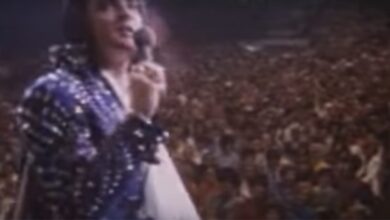The Emotional Duet Of “Don’t Cry Daddy” By Elvis And Lisa Marie Presley Might Bring Tears To Your Eyes
“Don’t Cry Daddy” is a poignant country ballad first recorded by Elvis Presley in 1969. The song, written by Mac Davis, narrates a touching story about a father who is trying to console his children following the death of their mother. The lyrics convey a deep sense of sorrow and loss, but also offer a message of hope and resilience. Presley’s heartfelt delivery and emotional performance made the song a standout in his catalog and endeared it to fans around the world. Its narrative exemplifies the struggles of grief and the strength found in familial love, making it resonate across generations.
Elvis Presley, known as the King of Rock ‘n’ Roll, had a profound impact on music across various genres, including country. Born in 1935 in Tupelo, Mississippi, Presley’s career began in the mid-1950s when he emerged as a transformative figure in American music. He became a cultural icon through his innovative approach to music, charismatic performances, and groundbreaking recordings. With a blend of rhythm and blues, gospel, and country influences, Presley introduced a new sound that captivated audiences and changed the landscape of music forever.
His influence extended into country music, where songs like “Don’t Cry Daddy” showcased his versatility and emotional depth as an artist. Presley’s ability to convey deep feelings through his music is evident in this ballad, allowing listeners to engage personally with its themes of mourning and comfort. The song stands as a testament to his ability to cross genre boundaries, reaching listeners of all backgrounds and ages. His unique vocal style, characterized by a powerful yet tender execution, brings a profound emotional weight to the narrative of the song.
In 1997, a unique and moving posthumous duet of “Don’t Cry Daddy” was released, featuring the vocals of Lisa Marie Presley, Elvis’s daughter. This collaboration utilized advanced digital technology, which allowed Lisa Marie’s voice to be digitally layered with her father’s original recording. The result was a powerful and emotional rendition that bridged the gap between two generations of music, showcasing how familial ties can be celebrated through art.
Lisa Marie Presley, born in 1968, followed in her father’s footsteps with her own musical career. Although she is often recognized for her connection to Elvis, she has carved out her own identity as a singer and songwriter. Participating in the duet of “Don’t Cry Daddy” added a deeply personal dimension to the song. Her contributions brought forth new perspectives on its themes, emphasizing the enduring bond between father and daughter while adding layers of emotional resonance.
The duet transcends conventional musical collaborations. It serves not only as a tribute to Elvis Presley’s enduring legacy but also highlights the intricate relationship between art and technology. The emotional depth of the song is amplified by Lisa Marie’s participation, which provides listeners with a sense of closure and continuity. Her presence on the track underscores the powerful connection between the two artists, making the experience particularly poignant for fans.
The technology used to create the duet involved sophisticated digital techniques, posing challenges to ensure compatibility between Lisa Marie’s vocals and Elvis’s original performance. This required meticulous attention to detail, maintaining the authenticity of the original recording while seamlessly integrating Lisa Marie’s voice. The final product achieved a hauntingly beautiful performance that resonates deeply with listeners, underscoring the emotional core of the song.
“Don’t Cry Daddy” remains a testament to the emotional power of music and its capacity to connect people across time and space. The duet not only revitalizes the original message but also illustrates how technology can preserve and celebrate musical legacies. As new generations discover and appreciate classic songs, they can find familiarity in the themes that continue to echo the human experience.
Moreover, the collaboration highlights the universal nature of grief and consolation. It reminds listeners that while loss is a common thread in human lives, the connection forged within a family can provide strength during difficult times. Music serves as a vessel for expressing emotions, and “Don’t Cry Daddy” encapsulates this sentiment in both its original form and the posthumous duet.
In conclusion, the posthumous duet of “Don’t Cry Daddy” stands as a moving homage to the song’s original emotional impact and the lasting legacy of Elvis Presley. It reflects the profound connection between father and daughter, illustrating how modern technology can offer new dimensions to beloved classic songs, granting fans a unique and heartfelt experience. This magnificent collaboration not only preserves the memory of an iconic artist but also reinforces the timeless power of music to touch lives and evoke deep emotions.





